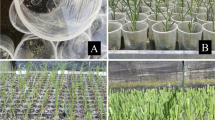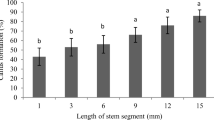Abstract
A system for subculture of spinach (Spinacia oleracea L.) roots was established, and differences in regeneration; namely, embryogenic competence, among individuals of the `Nippon' cultivar were examined. Root tissues, excised from seedlings, were grown on medium without growth regulators and subcultured on the same medium and then on medium that contained 10 μM naphthaleneacetic acid and 0.1 μM gibberellic acid to induce callus formation. Calli were transferred to medium without growth regulators. All explants formed calli. However, the frequency of embryo formation varied among lines. Higher concentrations of gibberellic acid in the callus-induction medium had limited effects on somatic embryogenesis from poorly embryogenic lines. These results indicate that inherent factors are important for somatic embryogenesis in spinach and that the root subculture system is useful for identifying strongly regenerative genotypes among individuals of a single cultivar.
Similar content being viewed by others
References
Adriance GW & Brison FR (1955) Inflorescences, flowers, fruits, and seed. In: Propagation of Horticultural Plants (pp 26–45). McGraw-Hill Book Company, Inc., NY, Toronto, London
Bingham ET, Hurley LV, Kaatz DM & Saunders JW (1975) Breeding alfalfa which regenerates from callus tissue in culture. Crop Sci. 15: 719–721
Bögre L, Stefanov I, Abraham M, Somogyi I & Dudits D (1990) Differences in responses to 2,4–dichlorophenoxyacetic acid (2,4–D) treatment between embryogenic and non-embryogenic lines of alfalfa. In: Progress in Plant Cellular and Molecular Biology (pp 427–436). Kluwer Academic Publishers, Dordrecht
Brown DCW, Finstad & Watson EM(1995) Somatic embryogenesis in herbaceous dicots. In: In vitro Embryogenesis in Plants (pp 345–415). Kluwer Academic Publishers, Dordrecht
Chen THH, Marowitch J & Thompson BG (1987) Genotypic effects on somatic embryogenesis and plant regeneration from callus cultures of alfalfa. Plant Cell Tiss. Org. Cult. 8: 73–81
Dodds JH & Roberts LW (1985) Root cultures. In: Experiments in Plant Tissue Culture (pp 94–103). Press Syndicate of the University of Cambridge, NY
Frankel R & Galun E (1977) Distribution of modes of reproduction among cultivated plants. In: Pollination Mechanisms, Reproduction and Plant Breeding (pp 16–28). Springer Verlag, Berlin, Heidelberg, NY
Gawel NJ & Robacker CD (1990) Genetic control of somatic embryogenesis in cotton petiole callus cultures. Euphytica 48: 249–253
Goto T, Miyazaki M & Oku M (1998) Varietal variations in plant regenerative potential from protoplasts in spinach (Spinacia oleracea L.). J. Jap. Soc. Hort. Sci. 67: 475–482
Jensen WA (1962) Histological procedures. In: Botanical Histochemistry (pp 55–99). W. H. Freeman and Co., San Francisco, London
Keyes GJ, Collins GB & Taylor NL (1980) Genetic variation in tissue cultures of red clover. Theor. Appl. Genet. 58: 265–271
Komai F, Okuse I & Harada T (1996a) Somatic embryogenesis and plant regeneration in culture of root segments of spinach (Spinacia oleracea L.). Plant Sci. 113: 203–208
Komai F, Okuse I & Harada T (1996b) Effective combinations of plant growth regulators for somatic embryogenesis from spinach root segments. J. Jap. Soc. Hort. Sci. 65: 559–564
Kumar S, Sharma P & Pental D (1998) A genetic approach to in vitro regeneration of non-regenerating cotton (Gossypium hirsutum L.) cultivars. Plant Cell Rep. 18: 59–63
Matheson SL, Nowak J & MacLean NL (1990) Selection of regenerative genotypes from highly productive cultivar of alfalfa. Euphytica 45: 105–112
Mii M, Nakano M, Okuda K & Iizuka M (1992) Shoot regeneration from spinach hypocotyl segments by short term treatment with 5,6–dichloro-indole-3–acetic acid. Plant Cell Rep. 11: 58–61
Mitten DH, Sato SJ & Skokut TA (1984) In vitro regenerative potential of alfalfa germplasm source. Crop Sci. 24: 943–945
Murashige T & Skoog F (1962) A revised medium for rapid growth and bioassays with tobacco tissue cultures. Physiol. Plant 15: 473–497
Okuse I, Ono K, Saga K & Komai F (1994) In vitro culture of excised roots in spinach (Spinacia oleracea L.). Bull Fac Agric Hirosaki Univ 58: 46–55 (in Japanese with English summary)
Sasaki H (1989) Callus and organ formation in tissue cultures of spinach (Spinacia oleracea L.). J. Japan Soc. Hort. Sci. 58: 149–153
White PR (1934) Potentially unlimited growth of excised tomato root tips in a liquid medium. Plant Physiol. 9: 585–600
Yu K & Pauls KP (1993) Identification of a RAPD marker associated with somatic embryogenesis. Plant Mol. Biol. 22: 269–277
Author information
Authors and Affiliations
Corresponding author
Rights and permissions
About this article
Cite this article
Ishizaki, T., Komai, F. & Masuda, K. Screening for strongly regenerative genotypes of spinach in tissue culture using subcultured root explants. Plant Cell, Tissue and Organ Culture 67, 251–255 (2001). https://doi.org/10.1023/A:1012791611632
Issue Date:
DOI: https://doi.org/10.1023/A:1012791611632




